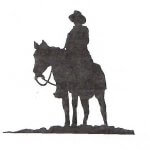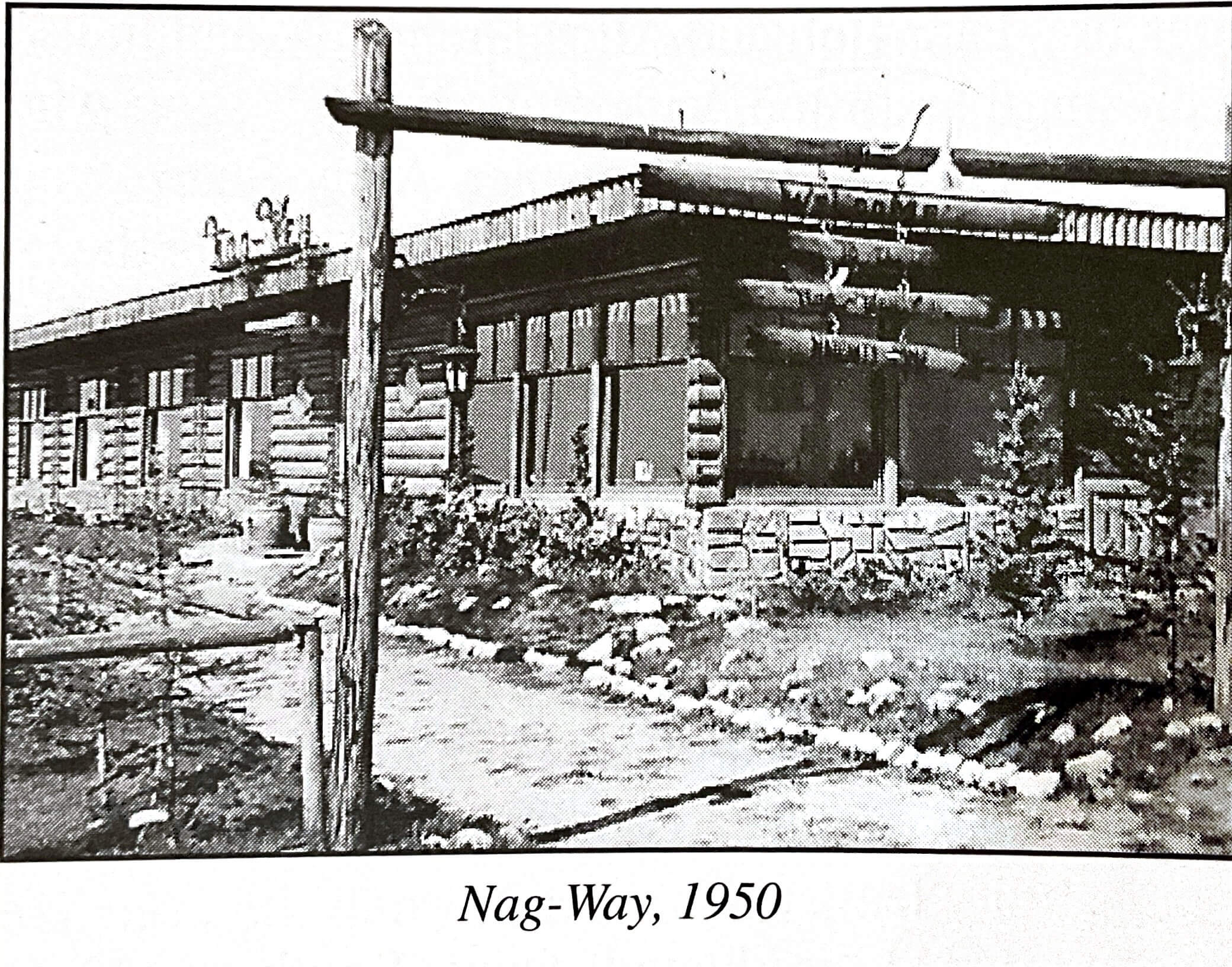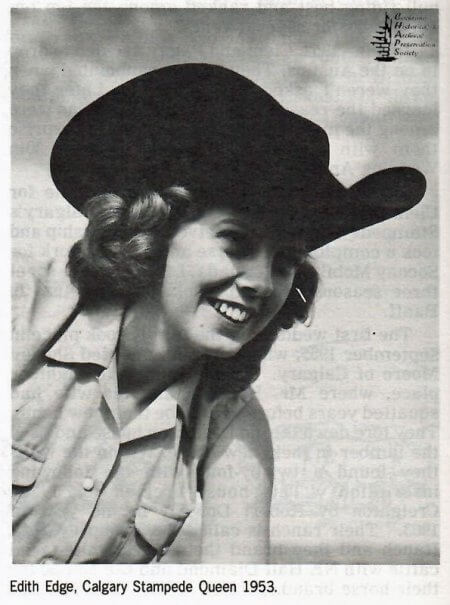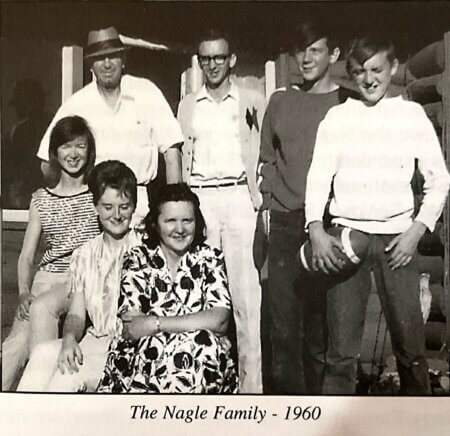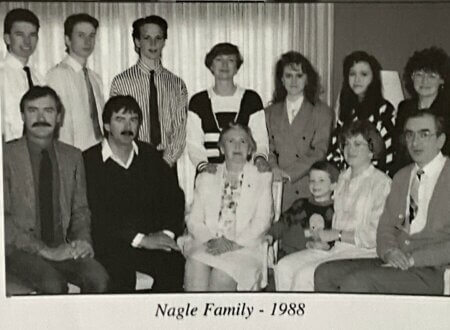By Gail Nagle Fraser pg 626 More Big Hill Country 2009
In 1949 our father Bertraem (Bert) Nagle and partner Doug Weyman purchased 5.5 acres from local farmer Lauritz Pederson out of one of the first subdivisions approved by the MD of Rockyview in the community of Bearspaw. The most scenic property along the Calgary to Banff highway, it overlooked the Bow Valley and the Rockies and Calgary’s skyline, a distant 10 miles east. Dad and Doug’s dream was to build and own their own restaurant and after two years of backbreaking labor while still holding jobs in Calgary, the Nag-Way Inn opened its doors as a dining room and lunch counter, serving lunches and dinners six days a week to highway traffic, neighbors and Calgarians. Its first function was a banquet for the Associated Canadian Travelers, who were sponsors of the annual Calgary Stampede Queen competition.
At the time Calgary was a city of less than 200,000 people, and its western boundary was 14 Street N. W. Calgarians were attracted to the unique location, a landmark log building sitting some 700 feet above the city with an unparalleled view of Rocky mountain sunsets. Photos from the early fifties show many noteworthy events being held at the Nag-Way, like then Mayor Don Mackay presenting his now traditional white hat to a visiting celebrity, and banquets honoring 1950’s Stampede Queens Edith Edge and Princess Wapiti. A 1950’s local television show featured western bands performing in the Nag-Way’s dining room.
As the only restaurant between Calgary and Cochrane for many years, it became a tradition for Calgary families out on a Sunday drive to stop in for our Sunday buffet dinners. The Nag-Way Inn specialized in serving prime aged Alberta beef, roast beef, super-sized steaks and home style Southern fried chicken, served in a rustic mountain lodge setting where diners could enjoy the magnificent view from the large picture windows and a crackling log fire in the huge fireplace. The interior walls were made of upright quarter logs and Dad hung bearskins, deer heads, snowshoes and wooden skis on the knotty pine walls. A stage was later added to hold live bands who entertained diners on Friday and Saturday nights, when the large polished pine floor would be filled with dancing couples until the early hours of the morning.
As manager and host, Dad made everyone coming through the doors feel like special guests, and started a tradition of hospitality that continued throughout his career as a restauranteur. Even in later years when he became the main chef and confined himself to overseeing the menus, guests would still come into the kitchen to greet him, as “Bert” and “the Nag-Way” were one and the same to them.
Local artist Gerda Christofferson persuaded Dad to hang her portraits of natives from the Morley reserve which were offered for sale. Several of these artworks remained there until the restaurant was closed down, when Dad and Mom gave one to each of the family as a memento. Several other artists such as Duncan Crockford admired and painted the Rockies from that viewpoint.
Within two years of its opening, Dad became the sole owner of the restaurant and later changed the spelling of its name to the Nag-Way Inn. He bought an old Chrysler limousine to haul staff and groceries every day to and from the city. For a few years, we saw little of our Dad, as he was gone from morning to late at night six days a week. In 1954 he moved Mom and our family of four children out to a home he built behind the restaurant. Between the house and the building were a series of wagon ruts crossing the acreage that we learned was the old Morley Trail, the main travel route since the late 1800s from the native reserve west of Cochrane to Calgary. Roger was 14 and Gail was 12 when they were bused by Cliff Gillespie to Glendale School, where Grades 6 to 9 were taught by Mrs. May Masters. Norman and Larry at 4 and 2 years old were too young to go to school yet.
Gail remembers:
“We were some of the first “city slickers” to move into the farming communities of Bearspaw and Glendale, and we soon got used to the new experiences of having to take our lunches to school and learn together with several other grades in a one room schoolhouse ruled by the stern Mrs. May Masters. Every morning Roger and I would walk up the road for about quarter mile to the Bearspaw School, where we’d pile into our school bus van driven by Bearspaw serv- ice station owner Cliff Gillespie for the long drive to Glendale School. Cliff would drop off the first to fifth graders at Bearspaw School and pick up the sixth to ninth graders along the bus route to Glendale School. Some of our schoolmates still rode their horses to school once in a while and stabled them in the old horse bam behind the school.
When we arrived at the school on wintry mornings, we would be warmed by the huge furnace in the corner of the schoolroom that had already been started by neighbors George or Mary Armstrong, the school care- takers. After storing our coats and boots in the cloak- room, we’d greet our teacher already seated at her desk with a “Good morning, Mrs. Masters”, and you knew what kind of a day it was going to be for you by whether she answered you not! Although she was only a little over five feet tall, she had no trouble keeping order in her classroom or disciplining the biggest of the grade nine boys like Bob Teghtmeyer or Bill Armstrong, who towered over her.
Since the schoolhouses were also the community halls for the districts of Glendale and Bearspaw, we students would clear the room of our desks and polish the floor the last school day before a dance, when families would get together to socialize.
We would have to be on our best behavior there, too, because our teacher was also part of the local orchestra and would keep a watchful eye out for us! We learned to waltz, polka, schottische, two step and square dance to the calls of Roy Teghtmeyer until midnight. Then, out would come the sandwiches and desserts that everyone would bring to share with coffee and tea before heading home.
Christmas concerts were a highlight of the school year, and plays, poetry, music and singing were all practiced for many weeks ahead of the “big night”. Roger remembers:
“We always played sports like baseball or games like ante-i-over or run sheep run at recesses. In the wintertime, we’d scrape off a nearby slough to play hockey every lunch hour, or if it was too cold outside we’d play ping-pong. We needed everyone in the school to make up teams no matter whether we were good enough at the sport or not. We all joined in, cooperated with each other and ended up becoming life-long friends.
As we got older, we had dances at the Nag-Way and then the Lions Club sponsored a teen club at the Lions Hall where we’d hold meetings to plan dances, hayrides at George Biggars and skating parties at the Newsome or Hamilton dams.”
In the 1950’s, Premier Ernest Manning’s government liquor regulations permitted drinking only in government approved beer parlours attached to hotels. Men and women weren’t even allowed to drink together in Calgary. Separate rooms in bars segregated men and women, except in rural hotel bars, resulting in people traveling to Cochrane, Okotoks and Airdrie in order to enjoy a drink together. Restaurants couldn’t get liquor licenses, and individuals or organizations had to apply for permits to purchase alcohol for their parties. The Nag-Way sold soft drinks and ice to diners to enable them to enjoy their alcohol with their meals that was brought with them in the form of a bottle of favorite wine or other beverage that was stashed “under the table” in a brown paper bag! The Nag-Way house band played weekends, and the large dance floor was a big attraction to dance to the “big band” music of the day like “In the Mood” or “Chattanooga Choochoo”. Supper club reservations were booked in advance, and New Year’s Eve was always a sold-out event.
Norman and Larry walked to nearby Bearspaw School, another one room schoolhouse, for their first 6 grades and were taught first by Mrs. Bennett and then by Mrs. Helen Scott. Norman spent Grades 7 and 8 at Silver Springs School, then was bused by Bob Thomas to the Cochrane High School for Grades 9 to 12. Larry was in the last class to be taught at Bearspaw School
and followed Norman one year later, as he skipped a grade. After many years of neglect, the Bearspaw School has been restored and moved to a new location near the Bearspaw Community Hall.
Norman remembers:
“There were six or seven of us kids in the neighborhood who loved to play hockey, so we’d talk our parents into helping us build and flood a skating rink behind Cliff Gillespie’s Esso service station. We kids would help finance paying for the boards to build it by selling jelly beans, and some nice parent like Ed Cushing or Cliff Gillespie would make up the difference. After every practice, we’d flood the rink again from the service station water supply so it was ready for the next day, and Cliff would sharpen our skates on his old bench grinder any time we needed them done. The Lions Club bought us sweaters one year, and we played against a team from Glendale School once in a while. We’d be there every day we could and all day Saturdays.”
After a couple of years living alone on the acreage, Mom moved in with Gail and her grandsons in Symons Valley for five years, and then moved into the city, where she lived independently until 2003, enjoying her children, grandchildren and great-grandchildren. The four of us children have remained in the Calgary area. Roger married Sharon Hott in 1961 and has two daugh- ters, Andrea and Colleen, who is married to Greg Garnsey and has a daughter Eden. Gail married Allan Fraser in 1965, is divorced and has three sons, James, Timothy and Christopher. James and his wife Elizabeth live in California and have two children, Kimberly and Brandon. Tim is married to Karl Maria and lives in Victoria while Chris lives in Vancouver. Norman mar- ried Janis Godfrey in 1975 and has a son, Jesse. Larry and his partner Shannon McGowan have a daughter Jennifer, her husband Dwayne Hanson and two grandchildren, Josiah and Abbey live in Chilliwack.
Norman, Janis and Jesse moved into the family home behind the Nag-Way in 1989 and still live there. After a series of severe falls and hospital stays, Mom died at 87 on November 21, 2006.
Since the Nag-Way Inn opened, the city of Calgary has expanded to within a half kilometer of the former restaurant, something never imagined by our Dad in 1949! For over 58 years the Nagle family has owned and enjoyed the Nag-Way property, extending through four generations. Currently the land is up for sale, as most of us children plan to retire away from Calgary, signaling the end of an era for the Nagle family in the Bearspaw community, and the Nag-Way Inn as a unique landmark to Calgary and the surrounding district.
